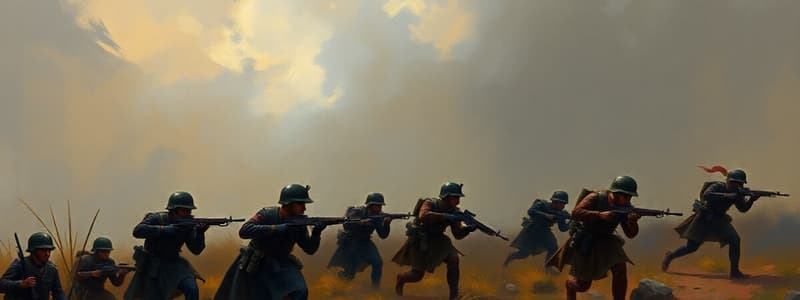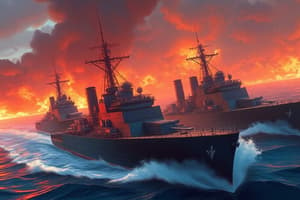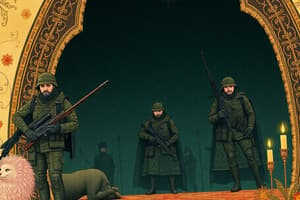Podcast
Questions and Answers
What is one of the motivations behind adversaries' actions to increase risk to the U.S. joint force?
What is one of the motivations behind adversaries' actions to increase risk to the U.S. joint force?
- To demonstrate their superior military capabilities
- To increase the likelihood of a friendly military response
- To strengthen responses from allied nations
- To raise the threshold for the U.S. to respond militarily to a provocation (correct)
Which of the following tactics do adversaries employ to exploit their freedom of action?
Which of the following tactics do adversaries employ to exploit their freedom of action?
- Providing humanitarian assistance to civilian populations
- Engaging in diplomatic negotiations to resolve conflicts
- Promoting international cooperation on environmental issues
- Conducting offensive cyberspace operations and disinformation campaigns (correct)
What is one of the challenges mentioned that intensifies as adversaries employ threat standoff approaches?
What is one of the challenges mentioned that intensifies as adversaries employ threat standoff approaches?
- Developing new recruiting methods for military personnel
- Building strong relationships with international organizations
- Maintaining control of strategic assets and logistics in a contested theater (correct)
- Negotiating peace treaties with opposing forces
Which of the following is NOT a challenge identified in the content as being intensified by threat standoff approaches?
Which of the following is NOT a challenge identified in the content as being intensified by threat standoff approaches?
What is the significance of the statement 'Army forces prepare to conduct operations in contested theaters...including in the United States'?
What is the significance of the statement 'Army forces prepare to conduct operations in contested theaters...including in the United States'?
According to the content, how do adversaries create a sense of uncertainty in their operations?
According to the content, how do adversaries create a sense of uncertainty in their operations?
Which of the following issues is directly addressed in the content as a result of adversaries' actions?
Which of the following issues is directly addressed in the content as a result of adversaries' actions?
The content states that adversaries employ different types of forces and capabilities to attack...what are these capabilities used for?
The content states that adversaries employ different types of forces and capabilities to attack...what are these capabilities used for?
What is the primary purpose of conventional warfare for a nation-state?
What is the primary purpose of conventional warfare for a nation-state?
What is the significance of the Peace of Westphalia (1648) in the context of conventional warfare?
What is the significance of the Peace of Westphalia (1648) in the context of conventional warfare?
How does conventional warfare typically differ from irregular warfare?
How does conventional warfare typically differ from irregular warfare?
What is the central focus of conventional warfare, as described in the text?
What is the central focus of conventional warfare, as described in the text?
Which of the following is NOT a characteristic of conventional warfare, as described in the text?
Which of the following is NOT a characteristic of conventional warfare, as described in the text?
What is the paradoxical effect of having combat-ready forces on the likelihood of large-scale combat and irregular warfare?
What is the paradoxical effect of having combat-ready forces on the likelihood of large-scale combat and irregular warfare?
Which of the following terms are often used interchangeably when describing the methods employed in a particular application, as mentioned in the text?
Which of the following terms are often used interchangeably when describing the methods employed in a particular application, as mentioned in the text?
Which of the following is NOT a reason why conventional warfare is referred to as “traditional” in the text?
Which of the following is NOT a reason why conventional warfare is referred to as “traditional” in the text?
What is the primary means by which a state or non-state actor satisfies its interests in armed conflict?
What is the primary means by which a state or non-state actor satisfies its interests in armed conflict?
What is the primary role of Army forces during armed conflict?
What is the primary role of Army forces during armed conflict?
What is the significance of the Army's presence on the ground in regards to deterring adversaries?
What is the significance of the Army's presence on the ground in regards to deterring adversaries?
How are the decisions made during competition and crisis phases related to the Army's preparedness for armed conflict?
How are the decisions made during competition and crisis phases related to the Army's preparedness for armed conflict?
Which of the following is NOT an example of a crisis that could escalate into armed conflict?
Which of the following is NOT an example of a crisis that could escalate into armed conflict?
Which of the following best describes the role of Army forces at the onset of an armed conflict?
Which of the following best describes the role of Army forces at the onset of an armed conflict?
Which of the following is NOT an example of an armed conflict?
Which of the following is NOT an example of an armed conflict?
What is the ultimate goal of Army forces in conducting operations during armed conflict?
What is the ultimate goal of Army forces in conducting operations during armed conflict?
Which of the following is NOT a tactic used by Army forces to avoid detection and mitigate the impact of enemy fires?
Which of the following is NOT a tactic used by Army forces to avoid detection and mitigate the impact of enemy fires?
What is the main challenge Army forces face when using dispersion tactics?
What is the main challenge Army forces face when using dispersion tactics?
During the initial phases of an operation, what is a primary consideration for deploying Army units?
During the initial phases of an operation, what is a primary consideration for deploying Army units?
What is the main reason for the increased likelihood of enemy use of massed long-range fires and weapons of mass destruction during large-scale combat operations?
What is the main reason for the increased likelihood of enemy use of massed long-range fires and weapons of mass destruction during large-scale combat operations?
What is NOT mentioned in the content as a factor that can lead to Army forces being relatively isolated during the early stages of an enemy attack?
What is NOT mentioned in the content as a factor that can lead to Army forces being relatively isolated during the early stages of an enemy attack?
Which of these is NOT a type of location that might be targeted by massed long-range fires and weapons of mass destruction?
Which of these is NOT a type of location that might be targeted by massed long-range fires and weapons of mass destruction?
What is the primary advantage of dispersion tactics in an offensive operation?
What is the primary advantage of dispersion tactics in an offensive operation?
In the context of the content, what is the significance of forward-stationed Army forces defending critical terrain with other coalition forces?
In the context of the content, what is the significance of forward-stationed Army forces defending critical terrain with other coalition forces?
Which of the following is NOT a defining element of war, as defined in the text?
Which of the following is NOT a defining element of war, as defined in the text?
According to the provided text, what is the distinction between 'war' and other human activities?
According to the provided text, what is the distinction between 'war' and other human activities?
The text mentions that the conduct and characteristics of war are influenced by changes in:
The text mentions that the conduct and characteristics of war are influenced by changes in:
Which of the following is a method of warfare as mentioned in the text?
Which of the following is a method of warfare as mentioned in the text?
What is the main purpose of the Army's multidomain operations concept, as described in the text?
What is the main purpose of the Army's multidomain operations concept, as described in the text?
Which of the following is NOT a key element of the Army's view of war, as presented in the text?
Which of the following is NOT a key element of the Army's view of war, as presented in the text?
How does the decision to wage war impact Army forces?
How does the decision to wage war impact Army forces?
The text mentions that war is 'inherently chaotic and uncertain'. What does this statement imply?
The text mentions that war is 'inherently chaotic and uncertain'. What does this statement imply?
What is the primary objective of irregular warfare?
What is the primary objective of irregular warfare?
Which of the following is NOT a distinguishing characteristic of irregular warfare?
Which of the following is NOT a distinguishing characteristic of irregular warfare?
Which of the following is an example of irregular warfare?
Which of the following is an example of irregular warfare?
Why is irregular warfare often considered a more economical way of waging war?
Why is irregular warfare often considered a more economical way of waging war?
How does irregular warfare differ from conventional warfare?
How does irregular warfare differ from conventional warfare?
Which type of Army forces are most commonly used in irregular warfare?
Which type of Army forces are most commonly used in irregular warfare?
What is the main advantage of using irregular warfare tactics?
What is the main advantage of using irregular warfare tactics?
What does the text suggest about the relationship between conventional warfare and irregular warfare?
What does the text suggest about the relationship between conventional warfare and irregular warfare?
Flashcards
Adversary Risk Increase
Adversary Risk Increase
Adversaries raise risk to the U.S. joint force to deter military response.
Dilution of Deterrence
Dilution of Deterrence
Adversaries weaken conventional deterrence, feeling freer to act.
Malign Activities
Malign Activities
Malicious actions taken by adversaries both domestically and internationally.
Cyber Operations
Cyber Operations
Signup and view all the flashcards
Plausible Deniability
Plausible Deniability
Signup and view all the flashcards
Threat Standoff
Threat Standoff
Signup and view all the flashcards
Contested Theaters
Contested Theaters
Signup and view all the flashcards
Information Warfare
Information Warfare
Signup and view all the flashcards
Objectives of War
Objectives of War
Signup and view all the flashcards
Nature of War
Nature of War
Signup and view all the flashcards
Elements of War
Elements of War
Signup and view all the flashcards
Political Purpose
Political Purpose
Signup and view all the flashcards
Chaotic and Uncertain
Chaotic and Uncertain
Signup and view all the flashcards
Human Endeavor
Human Endeavor
Signup and view all the flashcards
Multidomain Operations
Multidomain Operations
Signup and view all the flashcards
Threshold of Violence
Threshold of Violence
Signup and view all the flashcards
Conventional Warfare
Conventional Warfare
Signup and view all the flashcards
Military Forces
Military Forces
Signup and view all the flashcards
Strategic Purpose
Strategic Purpose
Signup and view all the flashcards
Warfighting Capabilities
Warfighting Capabilities
Signup and view all the flashcards
Key Terrain
Key Terrain
Signup and view all the flashcards
Irregular Warfare
Irregular Warfare
Signup and view all the flashcards
Weapons of Mass Destruction
Weapons of Mass Destruction
Signup and view all the flashcards
Conventional Deterrence
Conventional Deterrence
Signup and view all the flashcards
Freedom of Action
Freedom of Action
Signup and view all the flashcards
Deterrence
Deterrence
Signup and view all the flashcards
Crisis
Crisis
Signup and view all the flashcards
Armed Conflict
Armed Conflict
Signup and view all the flashcards
Forward-Positioned Forces
Forward-Positioned Forces
Signup and view all the flashcards
Joint Force Commands (JFCs)
Joint Force Commands (JFCs)
Signup and view all the flashcards
Political Settlement
Political Settlement
Signup and view all the flashcards
Primary Objective of Irregular Warfare
Primary Objective of Irregular Warfare
Signup and view all the flashcards
Nonmilitary Instruments of Power
Nonmilitary Instruments of Power
Signup and view all the flashcards
Irregular Warfare Focused Forces
Irregular Warfare Focused Forces
Signup and view all the flashcards
Irregular Warfare Capable Forces
Irregular Warfare Capable Forces
Signup and view all the flashcards
Economy of Force Effort
Economy of Force Effort
Signup and view all the flashcards
Political Context in Warfare
Political Context in Warfare
Signup and view all the flashcards
Cuban Revolution Example
Cuban Revolution Example
Signup and view all the flashcards
Constant Observation
Constant Observation
Signup and view all the flashcards
Short Notice Deployment
Short Notice Deployment
Signup and view all the flashcards
Facing Superior Threats
Facing Superior Threats
Signup and view all the flashcards
Massed Long-Range Fires
Massed Long-Range Fires
Signup and view all the flashcards
Dispersion Tactics
Dispersion Tactics
Signup and view all the flashcards
Counterreconnaissance
Counterreconnaissance
Signup and view all the flashcards
Terrain and Concealment
Terrain and Concealment
Signup and view all the flashcards
Offensive Maneuvering
Offensive Maneuvering
Signup and view all the flashcards
Study Notes
Chapter 1: Foundations of Operations
- War is an act of force to compel the enemy to comply
- Army operations focus on readiness for large-scale combat, multi-domain operations, and joint/multinational forces
- Army operations are crucial for understanding operational environments
Army Operations
- Army's primary mission: Organize, train, equip forces for land combat; defeat enemy ground forces and control land areas
- Four strategic roles: Shape environments, counter aggression, prevail in large-scale ground combat, and consolidate gains
- Strategic roles guide multi-domain operations by joint force commanders (JFCs) to achieve policy objectives. National-level leaders must orchestrate all national power instruments in coordination with allies.
- Land operations are foundational to other domains (e.g., air, sea). Conflicts often resolve on land.
- Operations are sequences of tactical actions with a common goal
- Operations vary in scale, duration, physical environments (urban, desert, etc.), and force involvement. They impact physical, information, and human aspects of operational environments.
- Successful operations require understanding both the science (combat power/ratios, ranges) and the art (leadership/morale/shock effect) of operations.
- Army operations encompass large-scale combat, limited contingencies, crisis response, and security cooperation.
Multidomain Operations
- Combined arms employment of joint and Army capabilities to achieve objectives, defeat enemy forces, and consolidate gains.
- Exploits all available combat power to accomplish missions efficiently.
- Applicable across the competition continuum (from competition to armed conflict for achieving policy objectives).
- Army operations in support of joint campaigns, especially in coalitions
Challenges for Army Forces
- The focus of U.S. military force is deterrence. Adversaries will use indirect strategies to avoid direct confrontation.
- Threat standoff approaches include spreading disinformation, coercion, proxy forces, etc
- Army forces must be prepared for a wide range of scenarios
- Maintaining the support of allies and partners is essential
- Locating information about, understanding the enemy, and sustaining operations are continuous challenges for Army forces in any operational environment.
Levels of Warfare
- National strategic (national policy/global strategy)
- Theater strategic (theater strategy/campaigns)
- Operational (major operations/battles/engagements)
- Tactical (small units/crew actions)
- National strategic level: U.S. government formulates and implements policy and mobilizes national instruments of power across all domains to achieve national objectives.
Studying That Suits You
Use AI to generate personalized quizzes and flashcards to suit your learning preferences.




